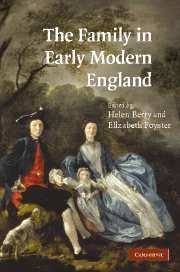Book contents
- Frontmatter
- Contents
- Preface
- Notes on contributors
- Anthony Fletcher
- 1 Introduction
- 2 Marriage, separation and the common law in England, 1540–1660
- 3 Republican reformation: Family, community and the state in Interregnum Middlesex, 1649–60
- 4 Keeping it in the family: Crime and the early modern household
- 5 Faces in the crowd: Gender and age in the early modern English crowd
- 6 ‘Without the cry of any neighbours’: A Cumbrian family and the poor law authorities, c.1690–1730
- 7 Childless men in early modern England
- 8 Aristocratic women and ideas of family in the early eighteenth century
- 9 Reassessing parenting in eighteenth-century England
- Select bibliography
- Index
2 - Marriage, separation and the common law in England, 1540–1660
Published online by Cambridge University Press: 31 July 2009
- Frontmatter
- Contents
- Preface
- Notes on contributors
- Anthony Fletcher
- 1 Introduction
- 2 Marriage, separation and the common law in England, 1540–1660
- 3 Republican reformation: Family, community and the state in Interregnum Middlesex, 1649–60
- 4 Keeping it in the family: Crime and the early modern household
- 5 Faces in the crowd: Gender and age in the early modern English crowd
- 6 ‘Without the cry of any neighbours’: A Cumbrian family and the poor law authorities, c.1690–1730
- 7 Childless men in early modern England
- 8 Aristocratic women and ideas of family in the early eighteenth century
- 9 Reassessing parenting in eighteenth-century England
- Select bibliography
- Index
Summary
King:
Shall I divorce them then? O be it far,
That any hand on earth should dare untie,
The sacred knot knit by Gods majesty;
I would not for my crown disjoin their hands
That are conjoined in holy nuptial bands,
How sayest thou Lacy? Wouldst thou loose thy Rose?
Thomas Dekker, The Shoemakers Holiday (1600)Lawrence Stone believed that from the time of the Reformation, which led to a narrowing of the grounds for annulment, until just prior to the Restoration, when private separation agreements became possible, the bonds of marriage were harder to break than at any other time in English history. Later historians have disagreed with Stone about the precise contours of marriage law and practice during these decades. R. H. Helmholz, for example, has questioned the ease with which the pre-Reformation church granted annulments, while Martin Ingram remains sceptical of Stone's assumptions about the prevalence of desertions after the Reformation. Nevertheless, few historians dispute the legal, ecclesiastical and social strength of the institution of marriage between the mid-sixteenth and mid-seventeenth centuries. Elsewhere in Europe, the Protestant reforms that removed marriage from its sacramental pedestal also ushered in the possibility of divorce, but in England divorce in the modern sense – the legal dissolution of a valid marriage allowing parties to remarry – remained unobtainable for most couples until 1857.
- Type
- Chapter
- Information
- The Family in Early Modern England , pp. 18 - 39Publisher: Cambridge University PressPrint publication year: 2007
- 1
- Cited by



